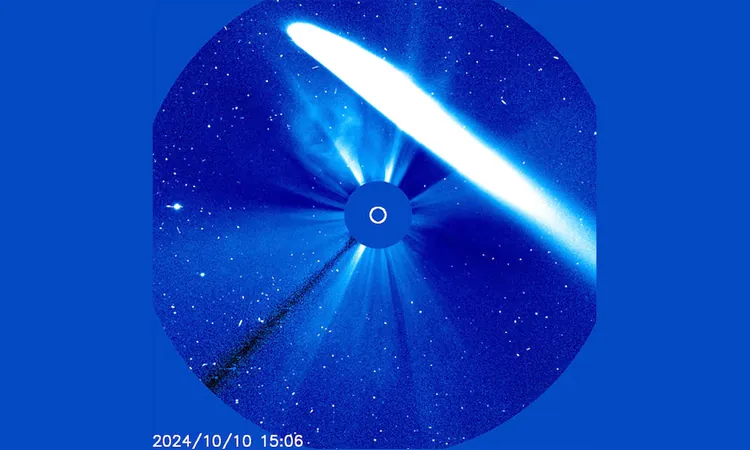
Revolutionary Navy Telescope Unveils Stunning Images of the Sun’s Corona and a Close Encounter with Comet Tsuchinshan-ATLAS!
2024-10-29
Author: Li
In an astonishing advancement for space weather monitoring, the U.S. Naval Research Laboratory (NRL) has successfully captured unprecedented images of solar eruptions and comets. The breakthrough comes thanks to the Compact Coronagraph (CCOR) telescope, which has recently provided its first images of coronal mass ejections (CMEs), marking a significant stride in our understanding of solar activity and its impacts on Earth.
First Glimpse of the Sun’s Majesty
Launched on June 25, 2024, aboard NOAA's GOES-19 satellite, the CCOR telescope was specifically designed to monitor the solar corona—the Sun's outer atmosphere. This remarkable telescope has become instrumental in tracking solar activity and providing early warnings about potential solar storms that could disrupt technology on Earth.
On September 19, after a meticulous setup, scientists opened CCOR’s aperture door to bask in the Sun’s rays for the first time. Equipped with a specialized device called an occulter, the telescope effectively creates an artificial eclipse, enabling enhanced observations of the corona and the CMEs that originate from it.
Capturing the Staggering Power of CMEs
On October 3, CCOR made headlines with a stunning observation of a CME known as a “halo.” These halos appear as circular features in coronagraph images, indicating that a powerful solar eruption is aimed directly at Earth. This specific event led to spectacular northern lights, visible across many U.S. states, as Earth's magnetosphere interacted with the solar winds produced by the CME.
Arnaud Thernisien, a research physicist at NRL, emphasized the significance of detecting halo CMEs, clarifying that they are especially concerning due to their potential to disrupt Earth’s magnetic field and impact satellites, communication systems, and power grids.
The Phenomenon of Comets
Aside from studying the Sun, CCOR’s success is complemented by another NRL instrument, the LASCO (Large Angle and Spectrometric Coronagraph) on the SOHO (Solar and Heliospheric Observatory) spacecraft. Recently, LASCO provided captivating images of comet Tsuchinshan-ATLAS as it passed perilously close to the Sun from October 7-11. Positioned at the Lagrange Point (L1), LASCO was ideally situated to capture the comet's dust trail, which illuminated dramatically under sunlight just as it made its approach to our star.
This encounter produced a rare spectacle, with the comet’s dust trail forming a distinct, dense band, offering scientists valuable insights into its composition and how solar conditions influence cometary behavior.
A Growing Network for Solar Observation
The combined capabilities of CCOR and LASCO represent a significant evolution in our ability to observe and interpret solar and comet activity. NRL is actively expanding this network, with plans for a second Compact Coronagraph (CCOR-2) set for launch in mid-2025, alongside a coronagraph for the European Space Agency’s (ESA) Vigil mission scheduled for 2031. This extensive array of instruments will enhance our capacity to monitor solar eruptions and their cosmic interactions, vital as we depend more on advanced technologies.
With ongoing analyses and real-time data collection, agencies like NOAA's Space Weather Prediction Center and the Department of Defense stand to benefit immensely from CCOR. Early detection of solar storms can provide critical alerts and help safeguard power grids and communication networks from potential disruptions.
Conclusion: Bridging Science and Technology
These groundbreaking discoveries underscore the necessity of robust space weather research as modern technology becomes increasingly reliant on the vicissitudes of solar activity. Understanding the dynamics of CMEs, comets, and their interactions with the Sun is not just about observation; it is about preserving the future resilience of our technological society.
As we look ahead, the advancements made by instruments like CCOR and LASCO promise to deepen our comprehension of the cosmos, equipping us with the knowledge to navigate the challenges posed by solar events. The dance of celestial bodies continues, and with it follows the relentless pursuit of scientific truth and technological endurance!
Stay tuned for more thrilling updates on space phenomena and breakthroughs in solar observations!

 Brasil (PT)
Brasil (PT)
 Canada (EN)
Canada (EN)
 Chile (ES)
Chile (ES)
 España (ES)
España (ES)
 France (FR)
France (FR)
 Hong Kong (EN)
Hong Kong (EN)
 Italia (IT)
Italia (IT)
 日本 (JA)
日本 (JA)
 Magyarország (HU)
Magyarország (HU)
 Norge (NO)
Norge (NO)
 Polska (PL)
Polska (PL)
 Schweiz (DE)
Schweiz (DE)
 Singapore (EN)
Singapore (EN)
 Sverige (SV)
Sverige (SV)
 Suomi (FI)
Suomi (FI)
 Türkiye (TR)
Türkiye (TR)